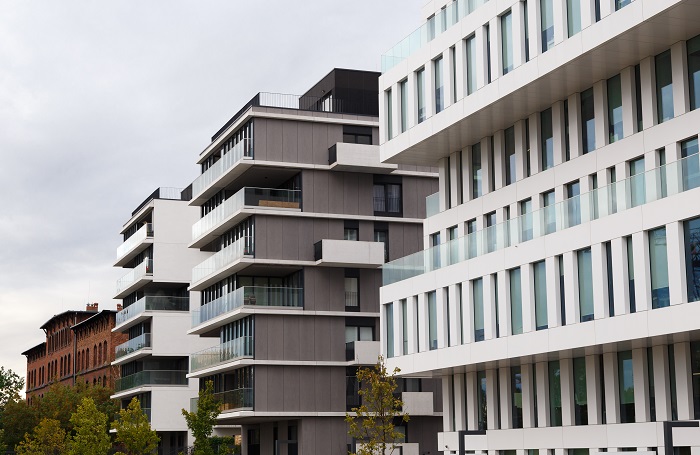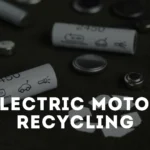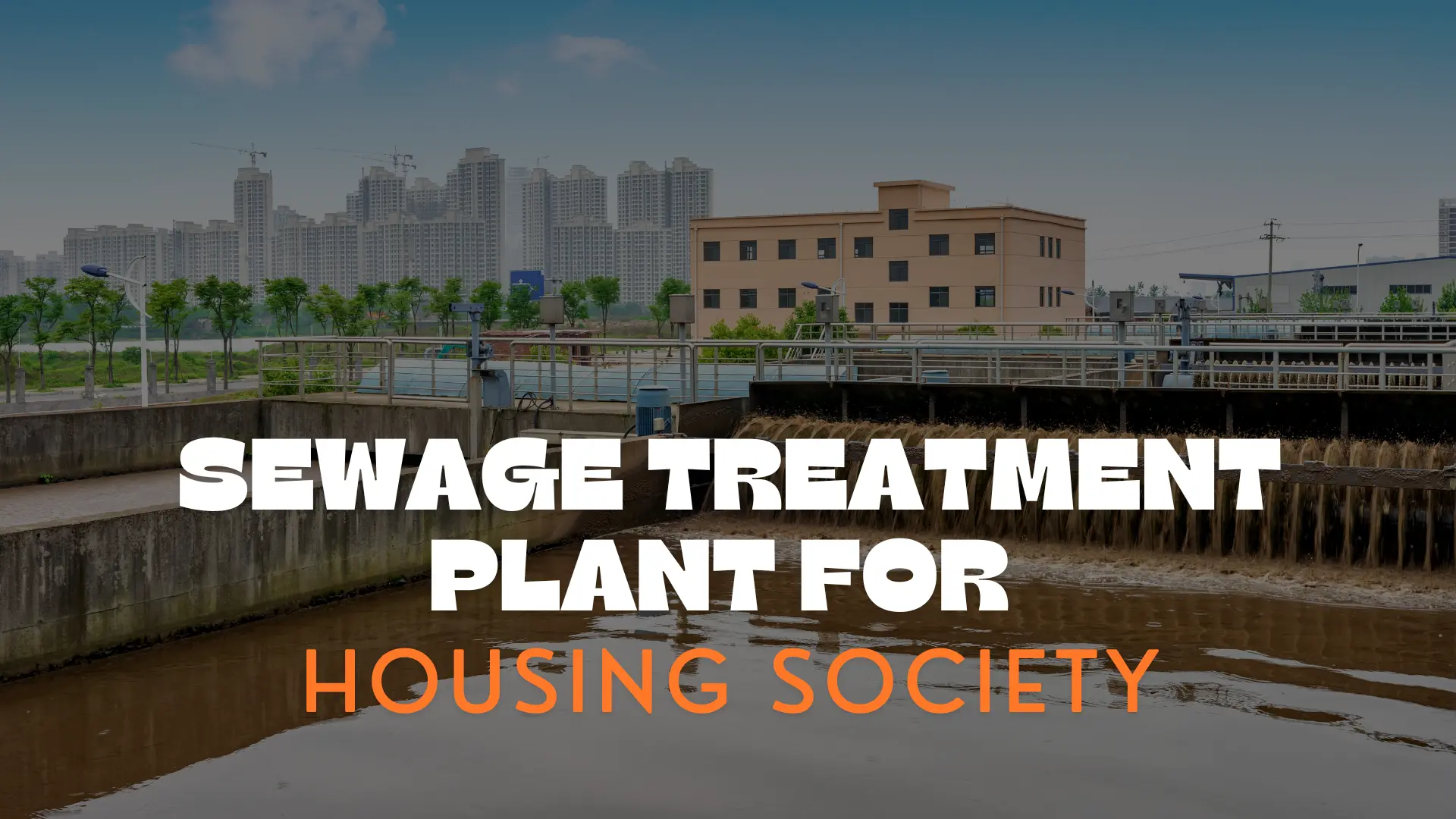What is a sewage treatment plant?
Sewage treatment plant for housing society is a must. In this blog you will learn about the importance of sewage treatment plants for housing society in detail. Have you ever wondered what happens to the waste water that comes from your household, kitchens, toilets and ends up by going to drainage?
Imagine if it is discarded as it is in water bodies without any treatment! It would be complete chaos. The whole aquatic ecosystem would get disturbed. So here comes the sewage treatment plant which plays a very crucial role in treatment of wastewater. Thus, the purpose of sewage treatment plants is to fulfill the demand of water scarcity in housing societies by reusing water.
Want to know more about how to implement sewage waste treatment plant in you society? Find Best Consultants for Solid Waste Treatment and Disposal here.
Introduction of sewage treatment plant
Sewage treatment or you may call it domestic wastewater treatment or municipal wastewater treatment. It is a type of wastewater treatment which aims to remove contaminants from sewage. Sewage treatment plants produce an effluent that is suitable for discharge to the surrounding environment. It can also be intended for reuse application, thereby preventing water pollution from raw sewage discharges. But what do you think sewage consists of? Sewage contains wastewater from households and businesses and possibly pre-treated industrial wastewater.
There are a high number of sewage treatment processes that you may choose according to your requirement. These can range from decentralized systems to large centralized systems. A decentralized system includes an on-site treatment system for sewage. Whereas, large centralized systems involve a network of pipes and pump stations called as sewerage which are used to convey the sewage to treatment plants. For cities that have a combined sewer, the sewers will also carry urban runoff that is stormwater to the sewage treatment plant. Also you should be aware that the separation and draining of household waste into greywater and blackwater is becoming more common in the developed world. Greywater is water generated from domestic activities such as laundry, dishwashing, and bathing, and can be reused more readily. Blackwater comes from toilets and contains human waste. Now let’s understand the process involved in a sewage treatment plant.
Sewage treatment plant processes
Now before going into details of sewage treatment plants for housing societies, let us know the working of sewage treatment plants. Feel the need to get expert guidance on this ? Connect with sewage treatment experts on our platform.
Fig: Layout of sewage treatment plant
Take a look at sewage sewage treatment plant steps. Following are the steps:-
| Steps | Processes |
| Step 1: Screening and Pumping | The incoming wastewater passes through screening equipment where objects such as rags, wood fragments, plastics, and grease are removed. The material removed is washed and pressed and disposed of in a landfill. The screened wastewater is then pumped to the next step. |
| Step 2: Grit Removal | In this step, heavy but fine material such as sand and gravel is removed from the wastewater. This material is also disposed of in a landfill. |
| Step 3: Primary Settling | The material, which will settle, but at a slower rate than step two, is taken out using large circular tanks called clarifiers. The settled material, called primary sludge, is pumped off the bottom and the wastewater exits the tank from the top. Floating debris such as grease is skimmed off the top and sent with the settled material to digesters. In this step, chemicals are also added to remove phosphorus. |
| Step 4: Aeration / Activated Sludge | In this step, the wastewater receives most of its treatment. Through biological degradation, the pollutants are consumed by microorganisms and transformed into cell tissue, water, and nitrogen. The biological activity occurring in this step is very similar to what occurs at the bottom of lakes and rivers, but in these areas the degradation takes years to accomplish. |
| Step 5: Secondary Settling | Large circular tanks called secondary clarifiers allow the treated wastewater to separate from the biology from the aeration tanks at this step, yielding an effluent, which is now over 90% treated. The biological activated sludge is continuously pumped from the bottom of the clarifiers and returned to the aeration tanks in step four. |
| Step 6: Filtration | The clarified effluent is polished in this step by filtering through 10 micron polyester media. The material captured on the surface of the disc filters is periodically backwashed and returned to the head of the plant for treatment. |
| Step 7: Disinfection | To assure the treated wastewater is virtually free of bacteria, ultraviolet disinfection is used after the filtration step. The ultraviolet treatment process kills remaining bacteria to levels within our discharge permit. |
| Step 8: Oxygen Uptake | The treated water, now in a very stabilized high quality state, is aerated if necessary to bring the dissolved oxygen up to permit level. After this step, the treated water passes through the effluent outfall where it joins the river or any different water bodies. The water discharged to the river must meet stringent requirements set by the authorities. Pollutant removal is maintained at 98% or greater. |
Explore Waste Water Treatment Solutions
Find top machinery, plants, tools, resources, companies, and consultancy for comprehensive Waste Water Treatment Solutions.
Types of sewage treatment plant
There are four major types of sewage treatment plants used in residential socities. Let’s have a look at different modern sewage treatment plant designs .
Activated sludge plant (ASP)
The activated sludge process is a type of biological wastewater treatment process. For treating sewage or industrial wastewaters using aeration and a biological floc composed of bacteria and protozoa. It uses air or oxygen and microorganisms to biologically oxidize organic pollutants, producing a waste sludge or floc containing the oxidized material.
The general arrangement of an activated sludge process for removing carbonaceous pollution includes the following items: An aeration tank in sewage treatment plant where air is injected in the mixed liquor. This is followed by a settling tank usually referred to as “final clarifier” or “secondary settling tank” to allow the biological flocs that is the sludge blanket to settle. Thus separating the biological sludge from the clear treated water. Part of the waste sludge is recycled to the aeration tank and the remaining waste sludge is removed for further treatment and ultimate disposal.
Fig:-Sewage treatment plant model
Trickling filter
A trickling filter is a type of wastewater treatment system. It consists of a fixed bed of rocks, coke, gravel, slag, polyurethane foam, sphagnum peat moss, ceramic, or plastic media over which sewage or other wastewater flows downward and causes a layer of microbial slime (biofilm) to grow, covering the bed of media. Aerobic conditions are maintained by splashing, diffusion, and either by forced-air flowing through the bed or natural convection of air if the filter medium is porous. The treatment of sewage or other wastewater with trickling filters is among the oldest and most well characterized treatment technologies.
The fundamental components of a complete trickling filter system are:
- a bed of filter medium upon which a layer of microbial slime is promoted and developed;
- an enclosure or a container which houses the bed of filter medium;
- a system for distributing the flow of wastewater over the filter medium; and
- a system for removing and disposing of any sludge from the treated effluent.
Membrane bioreactor
Membrane bioreactor (MBR) is a combination of membrane processes like microfiltration or ultrafiltration with a biological wastewater treatment process, the activated sludge process. It is now widely used for municipal and industrial wastewater treatment. In general, there are two different MBR configurations;
- Submerged membrane bioreactor (SMBR) and
- Side stream membrane bioreactor.
In the first configuration, the membrane is located inside the biological reactor, submerged in the wastewater. In the latter configuration, the membrane is located outside the reactor, as an additional step after biological treatment.
Struggling with Waste Water Treatment issues? Connect with top consultants specialising in Sewage Treatment Plant.
Connect NowRotating biological contactor
A rotating biological contactor or RBC is a biological fixed-film treatment process used in the secondary treatment of wastewater following primary treatment. The primary treatment process involves removal of grit, sand and coarse suspended material through a screening process, followed by settling of suspended solids. The RBC process allows the wastewater to come in contact with a biological film in order to remove pollutants in the wastewater before discharge of the treated wastewater to the environment, usually a body of water. A rotating biological contactor is a type of secondary (biological) treatment process. It consists of a series of closely spaced, parallel discs mounted on a rotating shaft which is supported just above the surface of the wastewater. Microorganisms grow on the surface of the discs where biological degradation of the wastewater pollutants takes place.
Rotating biological contactors (RBCs) are capable of withstanding surges in organic load. To be successful, micro-organisms need both oxygen to live and food to grow. Oxygen is obtained from the atmosphere as the disks rotate. As the micro-organisms grow, they build up on the media until they are sloughed off due to shear forces provided by the rotating discs in the sewage. Effluent from the RBC is then passed through a clarifier where the sloughed biological solids in suspension settle as a sludge.
Fig:-Sewage treatment plant design
Components of sewage treatment plant
Depending on the type of sewage, components of sewage treatment plants vary. Components associated with sewage treatment plants remove harmful contaminants from wastewater and household sewage before its release into the environment. Major components of sewage treatment plant includes:
- Bar screens
- Grit chamber
- Comminutors
- Pre-aeration tank
- Primary settling tank
- Aeration tank
- Secondary settling tank
- Biological filters
- Sudge handler
So besides this,customize components of sewage treatment plants as per your plant requirements can be designed.
Sewage treatment plant cost estimation
Sewage treatment plant function has a very important role in housing societies. Because wastewater treatment is highly complex. So for a custom solution, several factors go into choosing the right treatment option. It is crucial to treat your waste properly, before discharging wastewater into the environment. So domestic sewage treatment plants are the best solution to water pollution and recovery. Private and green sewage treatment plants (STP) are slowly gaining prominence. So residential sewage treatment plants play a crucial role to tackle the water scarcity problem.
Let’s take an example of Mumbai for sewage treatment plant design details for a project. Currently, it is mandatory for new and upcoming housing projects in Mumbai with a build-up area of more than 2,00,000 sq ft to have a private STP of their own. The same is true for complexes with a built up area of 4,30,000 sq ft in Thane, although there is a push to reduce the area to match Mumbai’s. The Brihanmumbai Municipal Corporation (BMC) also promises a 5% tax rebate for societies with an STP. For example, Hiranandani Communities in Kandivali, a society with 400 flats spends Rs 1-2 lakh per month on the running and maintenance of their STP. The cost is divided in the maintenance bills of the flats, says Sagar Vira, a resident. Considering the cost of municipal water is Rs 5.94 for every 1000 liters, the society is not saving any money by recycling water.
Typically, the developer installs an STP for the society during construction or redevelopment. Doing so has its advantages, as it means the layout, piping, electromechanical and civil work is embedded in the design of the buildings. The capital cost of the facility is also included in the whole cost. The builder takes care of the maintenance, administration and cost of the STP till the society is formed, after which it is transferred to them. But often, to skimp on expenses, builders opt for cheaper STPs without ensuring reliability or performance. The lack of an industry regulatory body, as there is with other electrical appliances like ACs, makes choosing a risky endeavor, and allows for subpar models to proliferate. Most builders do not opt for green STPs, increasing the society’s operational costs in the long run. So look at the cost estimation for a sewage treatment plant for apartments.
- The first step for an established society to acquire a green STP is inquiring with companies providing them. After a site visit, the company will furnish them with exact details, design, work and space needed and the cost based on the society’s needs and the particular STP’s technology.
- Each flat usually consumes half a kilolitre of water daily (kld), and the number of flats in a society will decide the capacity of the plant needed. An STP for a housing complex with 1,000 flats, with a capacity of 500 kld, will cost approximately Rs 90-110 lakhs, although this will differ depending on the type and technology used by the STP. This brings the cost per flat to approximately Rs 10,000.
- As the size of the plant decreases, however, the cost reduces at a slower rate. So for a society with 100 flats, an STP with a 50 kld capacity will cost Rs 25-30 lakh. But the burden on each flat will increase to Rs 30,000.
- A larger society with 400 flats will need an STP with a 200 kld capacity, costing around Rs 70-80 lakh.
- Each STP will require different amounts of space, depending on the size and type of the STP.
- Green STPs typically need more space than conventional STPs, but unlike the latter, the space can be reused. A conventional STP will need a cordoned off area for the equipment, but the area needed for a green STP can double as open space or a garden. Vision Earthcare requires 60 sq meters for a 100 kld plant, which can serve 200 flats.
- Apart from treating sewage, STPs extract the physical sludge and dirt that is part of wastewater. But the sludge collected from housing societies by green STPs is minute, and only needs to be cleaned once in a few years. A housing society in Virar which has installed an STP from Vision Earthcare carries out this cleaning process every 1,000 days, the contents of which they give to the municipal corporation and can be used as manure.
- After an STP is installed and set up, the society will have to employ people or an agency to take care of the plant on a day-to-day basis. Here, too, the disparity between a conventional STP and green STP are stark.
- Conventional STPs require a lot more manpower to manage each aspect of the plants working. Hirandanani Communities, for example, employs four people over two shifts in a day through an agency.
- Green STPs, on the other hand, require a lot less personal and professional maintenance and are more readily automated. A person is needed only for a few hours in a day, after which they usually either work in the society for other jobs or at other STPs in the area. Regular water checks and inspections are required.
- Some green STPs use an activated sand and charcoal filter for post-treatment, and this requires changing twice a month for optimal treatment.
- This increases the cost and maintenance needed, or the treatment quality suffers.
Find and Connect with Leading Companies Specializing in Sewage Treatment Plant
Get Connected Today
STPs at Maharashtra
Sewage treatment plant rules in India have been prescribed by CPCB. So under CPCB State Pollution Control Board (SPSB) estimated sewage generation for the State of Maharashtra is 9,107 MLD and total capacity (including proposed) is 9,819 MLD (195 STPs). Research depicts sewage generation, treatment capacity, operational capacity, actual utilization, compiled capacity, capacities of non operational STPs , under construction STPs and proposed STPs. Based
on the data, following observations are made:
- Installed capacity is 6,890 MLD (75.65 %) against sewage generation of 9,107 MLD.
- It shows that there is a gap of 2217 MLD (24.35 %) in treatment capacity.
- Out of 6,890 MLD of installed capacity developed, operationalized capacity is 6,366 MLD (92.39 %) and actual utilized capacity is 4,242 MLD. Further, the capacity of compiled STPs is only 3598 MLD.
Want a complete business plan on cost factors involving in setting up sewage treatment plant in housing society? Connect with consultants here.
Advantages of sewage treatment plant in housing society
There are many advantages of a sewage treatment plant in housing society. Let us see the benefits you get if you have a sewage treatment plant for residential buildings.
Saves water and money
Reusing the gray that is water from showers, baths, sinks, and laundry and black water from the toilet is a very pocket friendly method. By Treating water from your home that can be used to water the garden or surrounding landscape. No doubt that you’re saving money and keeping your garden green at the same time. Wastewater treatment is a great water saving method for dry areas or drought affected areas. We all are aware about water scarcity in different parts of the world. So treating wastewater is the best solution to save water.
Environmentally friendly
Advanced wastewater process protects the delicate balance in the groundwater. It protects the area by not releasing harmful pollutants in inland water bodies. A well functioning system is odorless. Further safeguarding water pollution in the area. Also it allows aquatic flora and fauna to intake safe water. So it avoids the spread of toxicity in the surrounding area.
Self-sufficient
A housing society sewage plant removes the need to pay for often expensive connections to the local sewage network. It also removes your reliance on an external system. That means if anything goes wrong you can deal with it promptly and personally. You’re not waiting for council repairs.This method of sewage treatment is also ideal for remote areas as the systems can be installed almost anywhere water treatment is needed.
Cost effective
Once installed and up and running the water treatment process is long lasting and very cost effective to operate with low maintenance requirements. Also minimal power needs to run the plant. So it’s a pocket friendly process with very good initiative.
Disease prevention
This is especially important in areas at serious risk of disease. Where sanitation practices are only the basic requirement. Wastewater treatment plants can help prevent the spread of disease as the process can kill off harmful microorganisms which cause serious diseases. Diseases such as dysentery, gastroenteritis, and cholera can be avoided if you have a sewage treatment plant in your housing society. Remember that prevention is better than cure!
Natural and toxic free process
Natural aerobic bacteria are used to help break down the sewage, removing many of the pollutants and bacteria. So, no harmful bacteria that implies no release of harmful toxicants. It’s an eco-friendly technology with various benefits.
Decrease ground pollution
The treatment process the sewage goes through oxidizes and absorbs the organic matter. Converting it to carbon dioxide, nitrogen, and water helps to lower the number of pollutants in the treated wastewater, protecting the streams, lakes and rivers from harmful bacteria and avoiding eutrophication of water bodies. Thus avoid leaching of water bodies and ground.

Explore the Best waste water Treatment Machinery and Plants for your Industrial Needs.
Connect TodayDisadvantages of sewage treatment plant in housing society
Everything in this world has two aspects to look at i.e. positive and negative. Now take a glimpse towards negative aspects of sewage treatment plants in housing society. These will let you understand the do’s and don’ts of sewage treatment plants, while construction.
Routine pumping out
Yearly or after every six months pumping out is required. In order to remove the build-up of sludge and scum. To avoid clogging the flow of waste and allow the system to operate effectively and efficiently. Failing to carry out solids removal can lead to system shutdown.
Bad Odor
If not maintained correctly, treatment plants can become smelly. The obvious smell from sewage is not at all tolerable. However imagine the odors like the smell of rotten eggs, from the hydrogen sulfide as well as a whiff of ammonia. It is not at all tolerable. It’s your responsibility to have rules and regulations for maintenance of STP.
Bacteria
A delicate balance of bacteria within the treatment plant helps to naturally break down the sewage. This balance can be disrupted under certain circumstances which can lead to a slowing down or even stopping of the treatment process. For example, bacteria can be damaged due to:
- a sudden increase in water or waste from your home
- the use of harsh chemicals in the home
- ambient temperature changes
An imbalance can result in contaminated waste being distributed to the surrounding environment.
Space
Area required for the sewage treatment plant should be analyzed first according to the requirement. A sewage treatment plant requires enough space to position the plant. Space for the treated water to distribute in an area as the required distance from boundaries should be allotted. Your local council or water authority will usually set these rules and regulations. You need to clear with all legal certified documents.
Installation costs
When compared with a connection to your local town sewage or a septic tank set-up the cost of a sewage treatment plant can be seen as a disadvantage. However, once installed then running costs are minimal.
Power
The wastewater treatment plant requires reliable electricity to operate. Sometimes due to irregular supply of electricity it may seem to be difficult to operate the sewage treatment plant for housing society. So, you must ensure a proper supply of electricity to work the system efficiently.
Garden restrictions
Care needs to be taken with the plants in the absorption area which can restrict the kind of garden you have. It is recommended that edible plants are not used, only grass or shrubs or trees with shallow root systems are included. No large trees or shrubs in the area as they can cause the pipes to block. Also nutrient balance in plants could get disturbed. So edible plants are avoided in housing society gardens.
Sewage treatment plant chemicals used
Different chemicals are used for sewage treatment plants. The use of various chemicals are discussed below.
1. Sodium Aluminate
One of the most important chemicals used in wastewater treatment plants is sodium aluminate. Sodium aluminate is a chemical that belongs to inorganic compounds. The liquid form of it works well as a phosphorus remover. Wastewater often contains phosphorus that is a kind of phosphoric calcium able to create hard substances in the environment. To avoid such a thing to happen, sodium aluminate functions to remove phosphorus and elevate the ph level of wastewater with extremely low ph. However, sodium aluminate is an inorganic insoluble chemical and it is only soluble with some chemicals. Thus, one has to be careful to only use it in the right dosage to avoid misuse and damage to the environment.
2.Aluminum Sulfate
Another important chemical in wastewater treatment plants is aluminum sulfate. Aluminum sulfate in wastewater plants acts as purifier of the wastewater. The chemical itself is soluble and easily reacts to the chemicals in wastewater. As a result, it produces protein antigens that break insoluble and hazardous chemicals.Moreover, it also helps to regulate the pH level of the chemical. Making the wastewater less dangerous to the environment.Thus, it is one of the most critical elements in water purification.
3.Sodium Hydroxide
Another chemical that works as a substance in wastewater treatment plants is sodium hydroxide. Sodium hydroxide belongs to an inorganic compound with the symbol NaOH. In wastewater treatment plants, sodium hydroxide has some functions such as pH stabilizer, metal precipitant and alkaline cleaner. The combination of sodium, hydrogen,and dioxide makes this chemical work well for wastewater treatment especially for the critical waste and potentially pollutant one. By using sodium hydroxide, a more free wastewater as well as safer waste is possible.
4.Polymer
Polymer is a well known chemical that has many functions in industry. Especially those related to plastic. It is also beneficial in wastewater treatment plants. The function of polymers is to coagulate any solid dirt and work in diluted water in order to free these materials from suspension. In order to use polymer in wastewater treatment, people need to dilute polymer with water with a concentration around 0.5 percent. After that, pour it along with a mechanical tool to get rid of those suspended solids.
5. Ferric Chloride
A chemical that is also present in wastewater treatment plants is ferric chloride. Ferric chloride is a corrosive chemical used in water purification and sewage treatment. The function of ferric chloride is to remove metal substances from the waste that are highly possible to harm the environment as well as living beings. It will remove the metal works and make it a less dangerous substance. After a use of it, there will be a slight color from the residue. This substance is very good for sewage treatment due to its effectiveness to deal with the heavy chemicals in most industry waste. To use ferric chloride, pour the liquid form of it in the dose mentioned on the label. Leave it until its corrosive effect wipes out the metal and heavy substance.
6. Ferrous Chloride
Ferrous chloride is similar to ferric acid but they are not the same. While they belong in the same class of iron oxide, ferrous chloride has different functions in wastewater treatment plants. The function of ferrous chloride in it is as a solution to remove fabric dye and other insoluble dye. Moreover, it also has the corrosiveness of its sibling ferric chloride. Therefore, it is also effective to get rid of metal chemicals from wastewater. In wastewater products, ferrous chloride often comes together with other chemicals in wastewater treatment plants such as alum and polymer.
7. Polyaluminum Chloride
In some products of wastewater treatment plants, they also use polyaluminum chloride. Polyaluminum chloride is a chemical belonging to the chloride class. The common function of polyaluminum chloride is as a coagulant in waste management as well as water purification. Moreover, it also helps reduce chemical sludge, higher pH and clearer water. This chemical itself is a derivation from some substances including polymer. Furthermore, experts claim PAC to be more stable and efficient as coagulant as its production itself is premeditated and intended for its very reason.
8. Hydrochloric Acid
While some chemicals work to elevate pH level, there are also chemicals to lower it. One of them is hydrochloric acid. While the chemical has many uses in industry. It also works for wastewater treatment. Its function is to lower the pH of the wastewater. Since wastewater often includes many wastes of industrial chemicals, the pH tends to be at an extreme level either higher or lower than normal. If the pH is higher, people can use hydrochloric acid as one of the compounds to lower the pH in water. By using this chemical, the pH of the water will be more acceptable when the company has to pour the wastewater in nature.
Other Chemicals Used in Wastewater Treatment Plants Include
Sulfur Dioxide
Magnesium Oxide
Calcium Oxide
Carbon Dioxide
So by using these various chemicals housing societies are responsible to make sure that the wastewater is friendly to nature.
CPCB standards for sewage treatment plant
There are some strict sewage treatment plant rules in India. General standards are prescribed by Central Pollution Control Board (CPCB) are as follow:-
- The waste waters and gasses are to be treated with the best available technology (BAT) in order to achieve the prescribed standards.
- The industries need to be encouraged for recycling and reuse of waste materials as far as practicable in order to minimize the discharge of wastes into the environments.
- The industries are to be encouraged for recovery of biogas, energy and reusable materials.
- While permitting the discharge of effluent and emission into the environment, State Boards have to take into account the assimilative capacities of the receiving bodies, especially water bodies so that quality of the intended use of the receiving waters is not affected. Where such quality is likely to be affected discharges should not be allowed into water bodies.
- The Central and State Boards shall put emphasis on the implementation of clean technologies by the industries in order to increase fuel efficiency and reduce the generation of environmental pollutants.
- All efforts should be made to remove color and unpleasant odor as far as practicable.
- The standards mentioned in the Schedule shall also apply to all other effluents discharged such as industrial mining, and mineral processing activities and sewage.
- The limit given for the total concentration of mercury in the final effluent of caustic soda industry, is for the combined effluent from (a) Cell house, (b) Brine Plant, (c) Chlorine handling, (d) hydrogen handling and (e) hydrochloric acid plant.
- All effluents discharge including from the industries such as cotton
textile, composite woolen mills, synthetic rubber, small pulp & paper, natural rubber, petro-chemicals, tanneries, point dyes,slaughter houses, food & fruit processing and dairy industries into
surface waters shall conform to be BOD limit specified above,
namely 30 mg/l.
- Biological oxygen demand sewage treatment plant for discharge an effluent having a BOD more
than 30 mg./l, the standards shall conform to those given, above
for other receiving bodies, namely, sewers, coastal waters, and
land for irrigation.
- In the case of fertilizer industry the limits in respect of chromium and fluoride shall be complied with at the outlet of chromium and fluoride removal units respectively.
- The chemical oxygen demands (COD) concentration in a treated effluent, if observed to be persistently greater than 250 mg/l before disposal to any receiving body (public sewer, land for irrigation, inland surface water and marine coastal areas), such industrial units are required to identify chemicals causing the same. In case these are found to be toxic as defined in the Schedule I of the Hazardous Rules 1989 the State Board in such cases shall direct the industries to install tertiary treatment stipulating time limit.
Effluent discharge standards for sewage treatment plant
Below are effluent discharge standards prescribed by CPCB.
| PARAMETERS | STANDARDS (Inland Surface Water) |
| Color and odor | Not objectionable |
| Suspended solidsmg/l, max. | 100 |
| Particle size ofsuspended solids | Shall pass 850 micronIS Sieve |
| pH value | 5.5 to 9.0 |
| Temperature | Shall not exceed 5 degree Celsius above thereceiving water temperature |
| Oil and grease,Mg / l max | 10 |
| Total residualchlorine, mg/l max | 1.0 |
| Ammoniacal Nitrogen (as N),mg/l, max | 50 |
| Free ammonia (as NH3), mg/l, max | 5.0 |
| Biochemical oxygen demand(BOD)(3 days at 27 degree Celsius),mg/l, max. | 30 |
| Chemical oxygen demand(COD)mg/l, max | 250 |
| Total nitrogen (as N); mg/l, max. | 100 |
Importance of sewage treatment plant in housing society
Sewage treatment plant definition itself explains its importance. Sewage treatment plants process and treat wastewater, breaking it down into a cleaner ‘effluent’. That can be returned back to nature in a safer, eco-friendly form. They help restore:- groundwater balance, curb diseases and stop degradation and pollution of the environment.
In housing societies, the treated water can be used for non potable purposes such as:-
- Gardening,
- Washing cars,
- Construction,
- Irrigation and
- Toilet flushing.
Cleaner water would minimize risk due to water borne diseases. It’s observed to have less negative environmental impact and less water pollution. Moreover, from a much narrower point of view, no house would have to pay for water tankers, because there’d be abundance of groundwater on macro scales and reusable water at community levels.
Now take a glimpse at the importance of sewage treatment plants. How it would get easier for you if you get a sewage treatment plant in your housing societies.
Self-sustainability
Since the township or any small or big housing society project accommodates a number of people. The treated water can be reused for toilet flushing. One of the household’s biggest uses of water, along with other domestic uses such as watering plants and cleaning the floor. If the water is treated to drinking water standards, then it can be as well used for drinking. Thus, the township can be self-sufficient when it comes to water needs in terms of sewage treatment.
Fertilizer Production
The sludge collected during the treatment process contains a large amount of biodegradable material. This sludge when treated under ‘sludge-drying’ lagoon method, which is one of the solids dewatering methods, results in a form of natural biodegradable fertilizer. This natural fertilizer can then be used to increase the crop yields at gardens and can also be used for home gardening day. Moreover, the sludge collected during the STP process can also be used for energy production. So, having an STP plant installed at large societies and townships can truly help in conserving water and producing energy, and in the process be self-sustainable. Also the same biodegradable material can be used for biogas from sewage treatment plants.
Waste reduction
Through the treatment of wastewater, the amount of waste that is released into the environment is considerably reduced, thereby improving the environment’s health. This, in turn, reduces the health risk associated with environmental pollution and the nearby water bodies remain uncontaminated. Through the treatment of wastewater, the amount of waste that is released into the environment is considerably reduced, thereby improving the environment’s health. This, in turn, reduces the health risk associated with environmental pollution. Hence the nearby water bodies remain uncontaminated.
Environmental impact of sewage treatment plant
Until now you have got the importance of sewage treatment plants in housing societies. Now take a look at how STP in your housing societies can eliminate many environmental problems.
- Sewage treatment plants can have significant effects on the aquatic ecosystem. It maintains the balance between biotic and abiotic systems.
- If there’s no sewage treatment plants installed. That means wastewater discharge in water bodies without nutrient removal. So, eutrophication of water bodies can be a problem.
- Water pollution is the contamination of water bodies, usually as a result of human activities, so that it negatively affects its uses.Water bodies include lakes, rivers, oceans, aquifers, reservoirs and groundwater.
- Thus improper maintenance of sewage treatment plants in housing societies results in contaminants. that are being introduced into these water bodies.
- Thus, further water pollution can be attributed to one of four sources: sewage discharges, industrial activities, agricultural activities, and urban runoff including stormwater.
- It can be grouped into surface water pollution (either fresh water pollution or marine pollution) or groundwater pollution. For example, releasing inadequately treated wastewater into natural waters can lead to degradation of these aquatic ecosystems.
- Water pollution can also lead to water-borne diseases for people using polluted water for drinking, bathing, washing or irrigation.
- Hence improper treatment of waste water reduces the ability of the water bodies to provide the ecosystem services such as drinking water and also decreases its self resilient property.
Frequently Asked Questions
Q1. Why is a sewage treatment plant required?
Answer- A sewage treatment plant is a facility that provides a systematic approach for treating human excreta and Wastewater. They function by reducing biological oxygen demand, removing any sludge, and preventing the release of disease-causing organisms into the environment.
Q2. Why do sewage treatment plants smell?
Answer- Foul smell at treatment plants originates from the anaerobic decomposition of organic compounds. A natural by-product of anaerobic digestion is Hydrogen sulfide (H2S), which gives off a strong smell of rotten eggs.
Q3. Which sewage treatment plant is best?
Answer- Biocell. Biocell’s sewage treatment plants are known for having the highest effluent quality for the lowest power consumption available on the market. These reliable and affordable sewage treatment solutions are available for residential, commercial and industrial properties.
Q4. How much does it cost to run a sewage treatment plant?
Answer- The cost component pertaining to the construction and installation varies from cities to cities. Typically , for installation of a plant of 8-10 KLD capacity would cost around Rs. 2.5-3 lakhs.
Q5. Does a sewage treatment plant need a soakaway?
Answer- A soakaway is not usually needed with a sewage treatment plant, but it is required with a septic tank. This is because the water released by a septic tank is treated effluent, meaning it has only gone through one stage of treatment.
Q6. Is the sewage treatment plant a septic tank?
Answer- Sewage treatment plants require electricity to power the air pump, whereas septic tanks do not. Septic tanks do not require servicing (but must be emptied), whereas sewage treatment plants must be serviced and emptied. Septic tanks need to be emptied more frequently than sewage treatment plants.
Q7. How long does a sewage treatment plant last?
Answer- The establishment of the wastewater treatment plant is estimated to have a life span of 50 years and used on a 24 h basis.
Q8. How often does a sewage treatment plant need emptying?
Answer- Low-budget STPs need frequent emptying and monitoring but even a good one would have to be desludged and serviced at least once a year. After desludging, it should be immediately refilled by water to balance the internal and external pressure
Q9. Can sewage treatment plants discharge to watercourse?
Answer- After being processed in a sewage treatment facility, wastewater is safe to release into a watercourse without hurting the environment.
Q10.Can I install my own sewage treatment plant?
Answer- If you are not connected to the municipal sewerage system, the chances are you might have to install a Septic System or Home Sewage Treatment Plant (HSTP). However, installing your own system is tricky and must be undertaken only if you have experience and if local council guidelines permit. So what are you waiting for? Connect to our consultants right now! Get easy access to information through our website.









